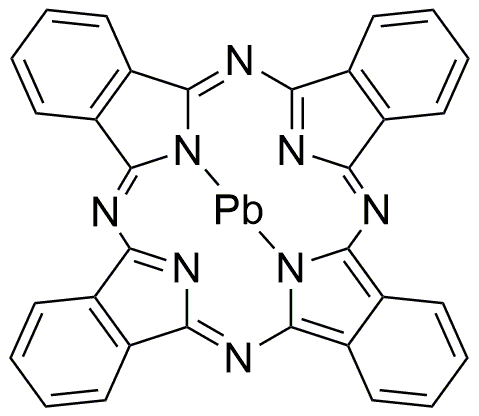Lead(II) phthalocyanine is widely utilized in research focused on:
- Dyes and Pigments: This compound serves as a vibrant dye in textiles and plastics, providing excellent color stability and lightfastness, making it ideal for outdoor applications.
- Electronics: It is used in the production of organic semiconductors, enhancing the performance of electronic devices like solar cells and light-emitting diodes (LEDs).
- Catalysis: In chemical reactions, it acts as a catalyst, improving reaction rates and efficiency, particularly in the synthesis of organic compounds.
- Coatings: Lead(II) phthalocyanine is incorporated into coatings for metals and plastics, offering protection against corrosion and enhancing durability.
- Research and Development: It is a valuable tool in laboratories for studying photochemical reactions and developing new materials, contributing to advancements in various scientific fields.
General Information
Properties
Safety and Regulations
Applications
Lead(II) phthalocyanine is widely utilized in research focused on:
- Dyes and Pigments: This compound serves as a vibrant dye in textiles and plastics, providing excellent color stability and lightfastness, making it ideal for outdoor applications.
- Electronics: It is used in the production of organic semiconductors, enhancing the performance of electronic devices like solar cells and light-emitting diodes (LEDs).
- Catalysis: In chemical reactions, it acts as a catalyst, improving reaction rates and efficiency, particularly in the synthesis of organic compounds.
- Coatings: Lead(II) phthalocyanine is incorporated into coatings for metals and plastics, offering protection against corrosion and enhancing durability.
- Research and Development: It is a valuable tool in laboratories for studying photochemical reactions and developing new materials, contributing to advancements in various scientific fields.
Documents
Safety Data Sheets (SDS)
The SDS provides comprehensive safety information on handling, storage, and disposal of the product.
Product Specification (PS)
The PS provides a comprehensive breakdown of the product’s properties, including chemical composition, physical state, purity, and storage requirements. It also details acceptable quality ranges and the product's intended applications.
Certificates of Analysis (COA)
Search for Certificates of Analysis (COA) by entering the products Lot Number. Lot and Batch Numbers can be found on a product’s label following the words ‘Lot’ or ‘Batch’.
Numéro de catalogue
Numéro de lot/série
Certificates Of Origin (COO)
This COO confirms the country where the product was manufactured, and also details the materials and components used in it and whether it is derived from natural, synthetic, or other specific sources. This certificate may be required for customs, trade, and regulatory compliance.
Numéro de catalogue
Numéro de lot/série
Safety Data Sheets (SDS)
The SDS provides comprehensive safety information on handling, storage, and disposal of the product.
DownloadProduct Specification (PS)
The PS provides a comprehensive breakdown of the product’s properties, including chemical composition, physical state, purity, and storage requirements. It also details acceptable quality ranges and the product's intended applications.
DownloadCertificates of Analysis (COA)
Search for Certificates of Analysis (COA) by entering the products Lot Number. Lot and Batch Numbers can be found on a product’s label following the words ‘Lot’ or ‘Batch’.
Numéro de catalogue
Numéro de lot/série
Certificates Of Origin (COO)
This COO confirms the country where the product was manufactured, and also details the materials and components used in it and whether it is derived from natural, synthetic, or other specific sources. This certificate may be required for customs, trade, and regulatory compliance.


